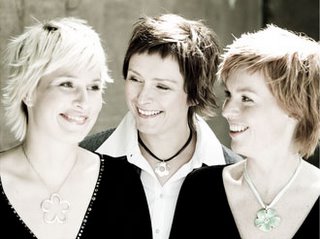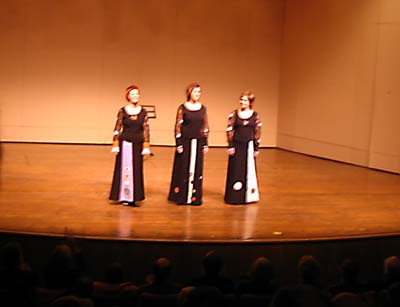Trio Mediæval at the Kennedy Center
 Trio Mediæval is a group of three women from Scandanavia (two from Norway, one originally from Sweden) -- Anna Maria Friman, Torunn Østrem Ossum, and founder Linn Andrea Fuglseth -- who specialize in singing late medieval polyphony and modern compositions in imitation of that style. Washington was the last leg on their six-city tour of the United States this month, only one day after their appearance at Carnegie Hall yesterday. Before that, from November 16 to 19, the group was involved in a collaboration with the German contemporary ensemble musikFabrik at the Brooklyn Academy of Music. Shelter is described as an oratorio with projections and music by the American composer-trio Bang on a Can (Julia Wolfe, David Lang, and Michael Gordon). Anne Midgette wrote the review (Lots of Brass, Waves and Sound, and, Sometimes, Silence, November 18) for the New York Times. Ionarts favorite Vilaine Fille posted about it and reviewed it (Gimme shelter from the storm, November 19) for Newsday. She is a longtime champion of the group.
Trio Mediæval is a group of three women from Scandanavia (two from Norway, one originally from Sweden) -- Anna Maria Friman, Torunn Østrem Ossum, and founder Linn Andrea Fuglseth -- who specialize in singing late medieval polyphony and modern compositions in imitation of that style. Washington was the last leg on their six-city tour of the United States this month, only one day after their appearance at Carnegie Hall yesterday. Before that, from November 16 to 19, the group was involved in a collaboration with the German contemporary ensemble musikFabrik at the Brooklyn Academy of Music. Shelter is described as an oratorio with projections and music by the American composer-trio Bang on a Can (Julia Wolfe, David Lang, and Michael Gordon). Anne Midgette wrote the review (Lots of Brass, Waves and Sound, and, Sometimes, Silence, November 18) for the New York Times. Ionarts favorite Vilaine Fille posted about it and reviewed it (Gimme shelter from the storm, November 19) for Newsday. She is a longtime champion of the group.
Needless to say, I was not going to miss the chance to hear Trio Mediæval live on Sunday evening in the mostly full Kennedy Center Terrace Theater, as part of the Fortas Chamber Music series. Their program, titled Seinte Mari Moder Milde, consisted mostly of music in honor of the Virgin Mary, not all of it from their new CD and much with a seasonally appropriate Christmas theme. It was amazing to hear even the most uncowed public coughers restrain themselves, to create the perfect envelope of silence for the precious sounds -- small, crystalline, fragile like threads of gold or saffron, but never brittle -- emanating from the perfectly matched voices of these performers. Each voice has its strengths, but they all sing in most ranges, freely switching parts from piece to piece, and sounding as uniform as possible on the rondellus pieces, where the voices regularly exchange melodic material.
David Patrick Stearns, Ancient airs (Philadephia Inquirer, December 4) Sabine Kortals, The sublime, given voice (Denver Post, December 5) Paul Horsley, Trio shows perfect blend can be nothing but treble (Kansas City Star, December 5) David Patrick Stearns, Medieval music with a modern bent (Philadelphia Inquirer, December 12) Allan Kozinn, Women's Voices Raised, Singing the Praises of the Medieval and the Modern (New York Times, December 12) Cecelia Porter, Trio Mediaeval (Washington Post, December 13) |
This is also true of the modern commissions that Trio Mediæval has been receiving. Again, the musicologist in me is thrilled because the group's influence brings younger composers into contact with medieval music. Clearly, Andrew Smith (who happens to be married to Ms. Fuglseth) is familiar with the group's repertoire. His Regina caeli (2002) was one of the best of the modern pieces on the program, beginning with the monophonic chant melody and then splashing it with deliciously dissonant harmonies. Composer Gavin Bryars followed the same process in his extraordinary Ave regina gloriosa, beginning with a medieval lauda melody instead of Gregorian chant. (Both of these pieces are on the group's second CD, Soir Dit-Elle, which I clearly need to acquire.) The connection of pretonal and post-tonal in the repertoire of Trio Mediæval is particularly satisfying and gives the lie to the preposterous notion that tonal music is somehow "natural." I do hope that Trio Mediæval will record the fascinating new piece Hymn to Seinte Mari, a setting of the original poem adapted by Benjamin Britten in his Hymn to the Virgin, by Isobel Davies (b. 1983).
 Probably due to tour exhaustion, the group omitted some verses and entire pieces that were listed in the program. Happily, this likely made possible the nearly flawless execution of this concert because they could focus their energy on a smaller range of pieces. The crowd was encouragingly mixed in age, and I suspect that some of the young women in the audience came specifically to hear Anna Maria Friman, who has a previous connection to Washington, D.C. She has worked as a coach for the Girl Choristers of Washington National Cathedral. In fact, all three members of the group have experience teaching children how to sing. In addition to their many talents, they are a refreshingly down-to-earth group of people. The friend I was with admired their New-Agey choice of outfits, blouses and skirts in combinations of orange, blue, black, and white, with felt cutouts of hearts and other shapes and frilly 70s-style cuffs.
Probably due to tour exhaustion, the group omitted some verses and entire pieces that were listed in the program. Happily, this likely made possible the nearly flawless execution of this concert because they could focus their energy on a smaller range of pieces. The crowd was encouragingly mixed in age, and I suspect that some of the young women in the audience came specifically to hear Anna Maria Friman, who has a previous connection to Washington, D.C. She has worked as a coach for the Girl Choristers of Washington National Cathedral. In fact, all three members of the group have experience teaching children how to sing. In addition to their many talents, they are a refreshingly down-to-earth group of people. The friend I was with admired their New-Agey choice of outfits, blouses and skirts in combinations of orange, blue, black, and white, with felt cutouts of hearts and other shapes and frilly 70s-style cuffs.If you missed the concert or if you were there and want to keep a piece of it for repeated listening, I highly recommend the latest recording from Trio Mediæval, Stella Maris, released earlier this fall. A group that sounds this good in a live concert, as you might imagine, offers a finished, edited recording that is beyond reproach. The first half of this CD is devoted to examples of English and Notre Dame polyphony. Nicky Losseff -- a lecturer in the University of York's Department of Music, where Ms. Friman is presently completing doctoral studies -- provided the transcriptions of these pieces and wrote the liner notes.
| Available from Amazon: Trio Mediæval, Stella Maris, released September 27 |
However, the best pieces on this CD are the conductus sung more or less as found in the medieval sources, like the too-brief Flos regalis virginalis, which the group also sang at the Kennedy Center. There is a nice facsimile of the first page of this English conductus in its original form, which is fun to follow as you listen to the piece (at least for musicological geeks like myself). The two longer Notre Dame conductus Veni creator spiritus and Dum sigillum have some delicious gnarled dissonances in them, which again give an important perspective on the modern pieces performed by this group. The two minutes of the plain homophony of Beata viscera, an English conductus for three even voices, are possessed with an oceanic calm.
The second half of the CD is a 25-minute setting of the Latin Ordinary, Missa Lumen de Lumine, by a Korean composer named Sungji Hong (b. 1973), who also studied at the University of York, where she met Ms. Friman. (The composer has made available a .PDF file of the first section of her Kyrie.) In its use of contrapuntal imitation, the style of the Kyrie is more neo-Renaissance than neo-medieval, with a sort of folk-like use of parlando and close harmony clusters. The Gloria and Credo play with sonic effects in mostly homophonic texture and call for some of the highest notes on the recording, especially in the former.
Upon repeated listening, I have not found the piece as engaging as the works by Gavin Bryars and Andrew Smith performed live at the Kennedy Center. However, the precision and beauty of tone from Trio Mediæval will take your breath away. They are routinely compared to the recently disbanded Anonymous 4, and indeed Trio Mediæval's recordings and live performances will appeal to the same niche of listeners. However, something about the simplicity in Trio Mediæval's approach is quite different from that of Anonymous 4, and the absence of that extra voice makes a difference, too.





















































5 comments:
Sounds great on a cold day. Also available on itunes.
what was that again about the monotonous 4?
Thanks for the review! They're coming to Seattle in spring, and now I'm even more excited to hear them!
Hey
your blog is very interesting here..
thanks for information
Thank you Li. You have "6" very informative blog, do you ever sleep?
Post a Comment